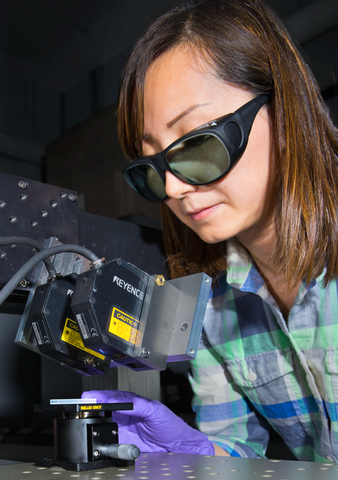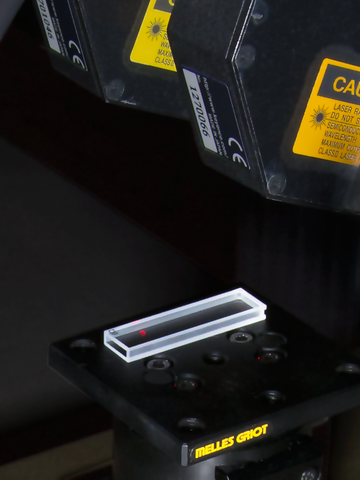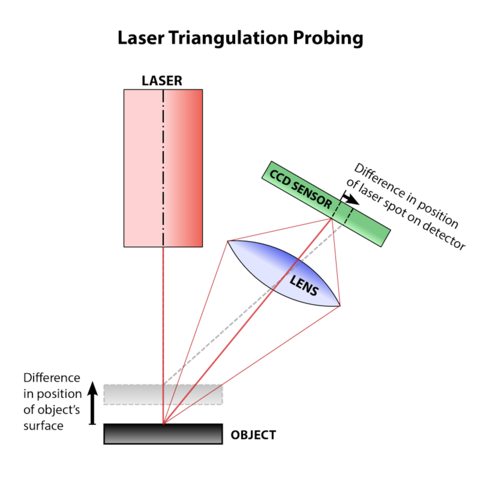Thinking Outside the Cuvette: To Measure Dimensions of Skinny Glass Container, PML Scientists Get Creative

Wei Ren with the triangulation probe and a cuvette.
Let's say you're a biotechnologist working to develop new medicines or a better test for forensic analysis. You might find yourself frequently using absorbance spectroscopy, a technique that allows researchers to identify even small amounts of a substance such as DNA or an antibody based on how it absorbs light.
To support these kinds of day-to-day measurements by people in the biotechnology community, NIST's Material Measurement Laboratory (MML) recently developed a new Standard Reference Material (SRM) designed for use with samples where only a small amount of the material is available. The new NIST resource, called SRM 2082, consists of two separate solutions, one of tryptophan, an amino acid, and one of uracil, a nucleic acid found in RNA.
But before MML staff could release its SRM to a waiting biotechnology community, they required an ultra-accurate determination of the width of the NIST cuvettes – tiny containers – used in the certification process. The width of the cuvettes determines the pathlength that light travels through these solutions.* So they called on a team of dimensional metrologists from NIST's Physical Measurement Laboratory (PML).

The gold standard for this type of measurement is a high-accuracy Coordinate Measuring Machine (CMM), whose hard probe tip physically touches the surface of an object to assess its dimensions, Wei explains. But in this case, alas, a CMM was out of the question.
The big challenge, Wei explains, was the large length-to-width ratio of the cuvettes. Although she had probe tips of the correct size, the smaller tips required shorter shafts in order to maintain proper stiffness, and those shafts were too stubby to reach the bottoms of the containers.
Wei considered other options. She often used laser triangulation probing, a non-contact technique, to measure the dimensions of ceramic or other opaque surfaces. The method involves shining a fat laser spot onto the surface of an object and collecting the incident light through a lens, which then focuses it onto a CCD. The position of the beam spot on the CCD varies with the distance to the object at that measurement point (see diagram below).
Though she had never used the method with transparent glass, Wei found a workaround: Instead of shining laser light straight down onto the cuvette, she shone it at a 20 degree angle. At each of the four interfaces between air and glass, the light was reflected back to the CCD detector. With this information, a computer program was able to work out the distances between each of the interfaces – in particular, between the two glass inner walls that determine each cuvette's "gap."

Her measurements yielded uncertainties of less than 1 micrometer (millionth of a meter). With this information, the MML team's resulting expanded uncertainty of the absorbance of the materials, as a function of pathlength, is less than 0.08 percent.
"We spent a lot of time unsuccessfully trying to come up with a 'complete probing' solution for this small high-aspect ratio measurement," says Eric Stanfield, Measurement Services Project Leader in PML's Dimensional Metrology Group. "Just when we thought we were out of options, Wei delivered success for the team by coming up with this alternative approach that combined probing and a non-contact technique that worked remarkably well.
"Measurement challenges are what make dimensional metrology so exciting and the ability to find creative solutions is almost a prerequisite for the job."
The new SRM 2082 is expected to be released by April 2016.
— Reported and written by Jennifer Lauren Lee
* The certified property of SRM 2082 is an equation which relates the pathlength of light through these solutions to their absorbance.

